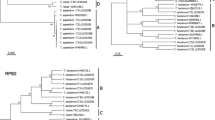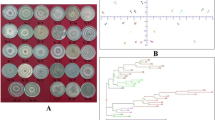Abstract
Twenty-one isolates of Trichoderma spp. were collected from eight states in Colombia and characterized based on the 5′ end of the translation elongation factor-1α (EF1-α1) gene and RNA polymerase II gene encoding the second largest protein subunit (RPB2) by using mixed primers. Seven species of soil-dwelling Trichoderma were found: T. atroviride, T. koningiopsis, T. asperellum, T. spirale, T. harzianum, T. brevicompactum and T. longibrachiatum. Species identifications based on the EF1-α1 gene were consistent with those obtained from the RPB2 gene. Phylogenetic analyses with high bootstrap values supported the validity of the identification of all isolates. These results suggest that using the combination of the genes EF1-α1 and RPB2 is highly reliable for molecular characterization of Trichoderma species. Trichoderma asperellum Th034, T. atroviride Th002 and T. harzianum Th203 prevented germination of more than 70 % of sclerotia of Sclerotinia sclerotiorum in bioassay tests and are promising biological control agents. No relationship between mycelium growth rate and parasitism level was found.





Similar content being viewed by others
References
Abdullah MT, Ali NY, Suleman P (2008) Biological control of Sclerotinia sclerotiorum (Lib.) de Bary with Trichoderma harzianum and Bacillus amyloliquefaciens. Crop Prot 27:1354–1359
Anas O, Reeleder RD (1987) Recovery of fungi and arthropods from sclerotia of Sclerotinia sclerotiorum in Quebec muck soils. Phytopathology 77:327–331
Anas O, Reeleder RD (1988) Consumption of sclerotia of Sclerotinia sclerotiorum by larvae of Bradysia coprophila: influence of soil factors and interactions between larvae and Trichoderma viride. Soil Biol Biochem 20:619–624
Bardin SD, Huang HC (2001) Research on biology and control of Sclerotinia diseases in Canada. Can J Plant Pathol 23:88–98
Bissett J (1984) A revision of the genus Trichoderma. I. Section Longibrachiatum sect. nov. Can J Bot 62:924–931
Bissett J (1991a) A revision of the genus Trichoderma II. Infrageneric classification. Can J Bot 69:2357–2372
Bissett J (1991b) A revision of the genus Trichoderma. III. Section Pachybasium. Can J Bot 69:2373–2417
Bissett J (1991c) A revision of the genus Trichoderma. IV. Additional notes on section Longibrachiatum. Can J Bot 69:2418–2420
Castle A, Speranzini D, Rghei N, Alm G, Rinker D, Bissett J (1998) Morphological and molecular identification of Trichoderma isolates on North American mushroom farms. Appl Environ Microbiol 64:133–137
Chaverri P, Samuels GJ (2003) Hypocrea/Trichoderma (Ascomycota, Hypocreales, Hypocreaceae): species with green ascospores. Stud Mycol 48:1–116
Cheney SA, Lafranchi-Tristem NL, Bourges D, Canning EU (2001) Relationship of microsporidian genera, with emphasis on the polysporous genera, revealed by sequences of the largest subunit of RNA polymerase II (RPB1). J Eukaryot Microbiol 48:111–117
Dodd SL, Lieckfeldt E, Samuels GJ (2003) Hypocrea atroviride sp. nov., the teleomorph of Trichoderma atroviride. Mycologia 95:27–40
Druzhinina I, Kubicek CP (2005) Species concepts and biodiversity in Trichoderma and Hypocrea: from aggregate species to species clusters? J Zhejiang Univ Sci B 2:100–112
Druzhinina IS, Schmoll M, Seiboth B, Kubicek CP (2006) Global carbon utilization profiles of wild-type, mutant, and transformant strains of Hypocrea jecorina. Appl Environ Microbiol 72:2126–2133
Elad Y (2000) Biological control of foliar pathogens by means of Trichoderma harzianum and potential modes of action. Crop Protect 19:709–714
Felsenstein J (1985) Confidence limits on phylogenies: an approach using the bootstrap. Evolution 39:783–791
Gallou A, Cranenbrouck S, Declerck S (2009) Trichoderma harzianum elicits defence response genes in roots of potato plantlets challenged by Rhizoctonia solani. Eur J Plant Pathol 124:219–230
Harman GE, Chet I, Baker R (1981) Factors affecting Trichoderma hamatum applied to seeds as a biocontrol agent. Phytopathology 71:569–572
Harman GE, Howell RC, Viterbo A, Chet I, Lorito M (2004) Trichoderma species—opportunistic, avirulent plant symbionts. Nat Rev Microbiol 2:43–56
Hirt PR, Logsdon JM Jr, Healy B, Dorey MW, Doolittle WF, Embley TM (1999) Microsporidia are related to Fungi: evidence from the largest subunit of RNA polymerase II and other proteins. Proc Natl Acad Sci USA 96:580–585
Hjeljord LG, Tronsmo A (2003) Effect of germination initiation on competitive capacity of Trichoderma atroviride P1 conidia. Phytopathology 93:1593–1598
Hjeljord LG, Tronsmo A (2005) Trichoderma and Gliocladium in biological control: overview. In: Harman GE, Kubicek CP (eds) Trichoderma and Gliocladium vol 2, Enzymes, biological control and commercial applications. Taylor and francis, Bristol, pp 115–133
Hoyos-Carvajal L, Duque G, Orduz PS (2008) Antagonism of Trichoderma spp. against isolates of Sclerotinia spp. and Rhizoctonia spp. in vitro. Rev Colomb Cienc Hortic 2:76–86
Hoyos-Carvajal L, Orduz S, Bissett J (2009) Genetic and metabolic biodiversity of Trichoderma from Colombia and adjacent neotropic regions. Fungal Genet Biol 46:615–631
Inbar J, Menendez A, Chet I (1996) Hyphal interaction between Trichoderma harzianum and Sclerotinia sclerotiorum and its role in biological control. Soil Biol Biochem 28:757–763
Jaklitsch WM (2009) European species of Hypocrea Part I. The green-spored species. Stud Mycol 63:1–91
Jukes TH, Cantor CR (1969) Evolution of protein molecules. In: Munro HN (ed) Mammalian protein metabolism. vol III, Academic Press, New York. pp 21–132
Karthikeyan M, Radhika K, Mathiyazhagan S, Bhaskaran R, Samiyappan R, Velazhahan R (2006) Induction of phenolics and defense-related enzymes in coconut (Cocos nucifera L.) roots treated with biocontrol agents. Braz J Plant Physiol 18:367–377
Keszler A, Forgacs E, Kótai L, Vizcaino JA, Monte E, Garcia-Acha I (2000) Separation and identification of volatile components in the fermentation broth of Trichoderma atroviride by solid-phase extraction and gas chromatography-mass spectrometry. J Chromat Sci 38:421–424
Kim TG, Knudsen GR (2008) Quantitative real-time PCR effectively detects and quantifies colonization of sclerotia of Sclerotinia sclerotiorum by Trichoderma spp. Appl Soil Ecol 40:100–108
Knudsen GR, Eschen DJ, Dandurand LM, Bin L (1991) Potential for biocontrol of Sclerotinia sclerotiorum through colonization of sclerotia by Trichoderma harzianum. Plant Dis 75:446–470
Kubicek I, Kullnig-Gradinger C, Szakacs G (2003) Genetic and metabolic diversity of Trichoderma: a case study on South-East Asian isolates. Fungal Genet Biol 38:310–319
Kullnig C, Mach RL, Lorito M, Kubicek CP (2000) Enzyme diffusion from Trichoderma atroviride (=T. harzianum P1) to Rhizoctonia solani is a prerequisite for triggering of Trichoderma ech42 gene expression before mycoparasitic contact. Appl Environ Microb 66:2232–2234
Mach RL, Peterbauer CK, Payer K, Jaksits S, Woo SL, Zeilinger S, Kullnig CM, Lorito M, Kubicek CP (1999) Expression of two major chitinase genes of Trichoderma atroviride (T. harzianum P1) is triggered by different regulatory signals. Appl Environ Microb 65:1858–1863
Martinez D, Chapman J, Berka RM, Henrissat B, Saloheimo M, Arvas M, Baker SE et al (2008) Genome sequencing and analysis of the biomass-degrading fungus Trichoderma reesei (syn. Hypocrea jecorina). Nat Biotechnol 26:553–560
Menzies JG (1993) A strain of Trichoderma viride pathogenic to germinating seedlings of cucumber, pepper and tomato. Plant Pathol 42:784–791
Mittermeier R, Mittermeier C (1997) Megadiversity: Earth’s biologically wealthiest nations. CEMEX, Mexico City, p 501
Oh SU, Lee SJ, Kim JH, Yoo ID (2000) Structural elucidation of new antibiotic peptides, atroviridins A, B and C from Trichoderma atroviride. Tetrahedron Lett 41:61–64
Ohata K (1989) Fungus disease. In: Ohata K (ed) Rice diseases in Japan. ZenkokuNosonKyoikuKyokai, Tokyo, pp 278–280 (in japanese)
Ospina-Giraldo MD, Royse DJ, Thon MR, Chen X, Romaine CP (1998) Phylogenetic relationships of Trichoderma harzianum causing mushroom green mold in Europe and North America to other species of Trichoderma from world-wide sources. Mycologia 90:76–81
París MA, Cotes AM, Beltrán C (2003) Selección de una cepa de Trichoderma sp. con actividad biocontroladora de Rhizoctonia solani en tubérculos de papa. Memórias XXIV Congreso Ascolfi, 23–27 June 2003, Armenia. Quindio, Colombia, p 23
Purdy LH (1979) Sclerotinia sclerotiorum: history, diseases and symptomatology, host range, geographic distribution and impact. Phytopathology 69:875–880
Rifai MA (1969) A revision of the genus Trichoderma. Mycol pap 116:1–56
Saitou N, Nei M (1987) The neighbor-joining method: a new method for reconstructing phylogenetic trees. Mol Biol Evol 4:406–425
Samuels GJ, Ismaiel A, Bon MC, de Respinis S, Petrini O (2010) Trichoderma asperellum sensu lato consists of two cryptic species. Mycologia 102:944–966
Schwartz HF, Steadman JR (1978) Factors affecting Sclerotium populations and apothecium production by, Sclerotinia sclerotiorum. Phytopathology 68:383–388
Sharma K, Mishra AK, Misra RS (2009) Morphological, biochemical and molecular characterization of Trichoderma harzianum isolates for their efficiency as biological control agents. J Phytopathol 157:51–56
Shoukouhi E, Bissett J (2008) Preferred primers for sequencing the 5′ end of the translation elongation factor 1-alpha gene (EF1-α1) and subunit 2 of the RNA polymerase B gene (RPB2). http://www.isth.info/methods. Verified Dec 13, 2010
Simberloff D, Stiling P (1996) How risky is biological control? Ecology 77:1965–1974
Watanabe S, Kumakura K, Kato H, Iyozumi H, Togawa M, Nagayama K (2005) Identification of Trichoderma SKT-1, a biological control agent against seedborne pathogens of rice. J Gen Plant Pathol 71:351–356
Williamson M (1992) Environmental risks from the release of genetically modified organisms (GMOs) the need for molecular ecology. Mol Ecol 1:3–8
Acknowledgments
We thank Dr. Víctor Núñez, Dr. Carolina González, Mr. Jhon Pablo Vargs and various colleagues at the Biological Control Laboratory and Plant Genetics Molecular Laboratory in Corpoica for their help and kindness. M.D. is appreciative of helpful advice from Dr. Masuya Hayato of the Forestry and Forest Products Research Institute in Japan.
Author information
Authors and Affiliations
Corresponding author
Rights and permissions
About this article
Cite this article
Smith, A., Beltrán, C.A., Kusunoki, M. et al. Diversity of soil-dwelling Trichoderma in Colombia and their potential as biocontrol agents against the phytopathogenic fungus Sclerotinia sclerotiorum (Lib.) de Bary. J Gen Plant Pathol 79, 74–85 (2013). https://doi.org/10.1007/s10327-012-0419-1
Received:
Accepted:
Published:
Issue Date:
DOI: https://doi.org/10.1007/s10327-012-0419-1




